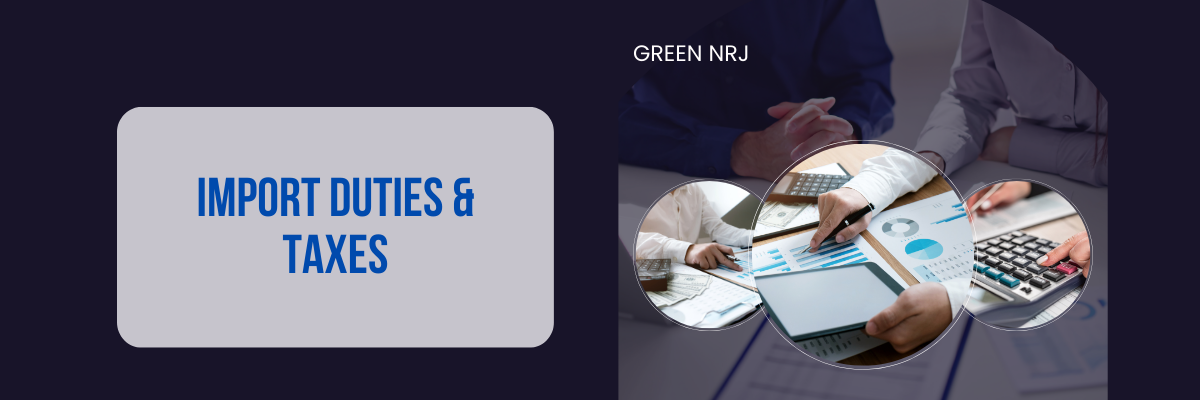- If you have any questions, please contact us!
- +84 965 624 065
- info@greennrj.com.vn

Comprehensive Procedure for Importing Honey into Vietnam 2025
May 1, 2025
Are Natural-Origin Cosmetic Ingredients Exempt from Disclosure in Vietnam 2025?
May 5, 2025With Vietnam’s economic growth and integration into global trade, it has become an increasingly attractive destination for foreign investors and importers. However, understanding the country’s tax and customs systems—especially Import Duty and Value Added Tax (VAT)—can be a challenge for businesses unfamiliar with the Vietnamese market.
Failure to comply with import tax regulations may result in shipment delays, unexpected costs, penalties, or even legal disputes. Therefore, it is crucial to understand how import duties and VAT work, how they are calculated, and how to manage them effectively.
1. Taxation Overview for Imported Goods in Vietnam
When importing goods into Vietnam, businesses must prepare for multiple layers of taxation, which may include:
- Import Duty
- Value Added Tax (VAT)
- Special Consumption Tax (SCT) (for luxury or harmful goods)
- Environmental Protection Tax (for environmentally sensitive items)
- Additional Import Duties (for products subject to trade defense measures)
Among these, Import Duty and VAT are the most common and directly affect your landed cost. Let’s explore these two in detail.
2. Import Duty in Vietnam
2.1 What is Import Duty?
Import Duty is a tax levied by the Vietnamese government on foreign goods entering the country. It serves as a protective measure for domestic industries and is applied to all goods (but not services) crossing the Vietnamese border.
Import duty is collected by Vietnamese Customs at the port of entry. This duty is considered indirect, as it is generally included in the cost of the final product and passed on to consumers.
Any entity—foreign or local—that imports goods into Vietnam is legally obligated to pay this tax. Non-compliance can result in confiscation, fines, and even blacklisting by customs authorities.
For a more in-depth understanding of Vietnam’s import tax regulations, visit the official Vietnam Customs Department website, where you can access comprehensive guidelines on import duties, VAT, and other crucial tax-related details.
2.2 Factors Affecting Import Duty Calculation
Several key variables influence how import duty is determined:
- CIF Value: This is the declared value of the imported goods, including Cost, Insurance, and Freight. The higher the CIF, the more import duty is payable.
- HS Code: The Harmonized System code is a standardized international code used to classify traded products. The HS code determines the applicable duty rate.
- Product Description: Descriptions must be accurate and specific. Vague or misleading descriptions can cause misclassification, which may trigger audits or fines.
- Country of Origin: Vietnam applies different duty rates based on trade agreements. Goods from countries with Free Trade Agreements (FTAs) often benefit from reduced or zero duties.
- Applicable Trade Agreements: Vietnam has signed multiple FTAs, including CPTPP, EVFTA, and ASEAN agreements, all of which influence the duty rate for imports from member countries.
2.3 How to Calculate Import Duty
Import duty in Vietnam is calculated using the following formula:
Import Duty = CIF Value × Import Duty Rate
Let’s break this down:
- CIF Value: Cost + Insurance + Freight (declared at the time of customs clearance)
- Import Duty Rate: This is a percentage determined by the HS code and the country of origin.
For example:
- A company imports goods with a CIF value of $10,000
- The duty rate is 10% (based on HS code and origin)
Import Duty = $10,000 × 10% = $1,000
So, the importer must pay $1,000 in import duty at customs.
2.4 Types of Import Duty Rates in Vietnam
Vietnam uses a three-tiered import duty system:
- Preferential Rates
Applied to goods from countries that have Most-Favored Nation (MFN) status under World Trade Organization (WTO) agreements.
➤ Legal Basis: Article 11, Law on Export and Import Duty 2016 - Special Preferential Rates
Applied to imports from countries with which Vietnam has a Free Trade Agreement (FTA). These rates are typically lower and sometimes 0%.
- Ordinary Rates
Applied to imports from countries without any trade agreement with Vietnam. These are the highest rates and often calculated as 150% of the MFN rate.
Correctly identifying which category your goods fall under is critical to determine the right import duty rate.
2.5 Importance of HS Codes
HS codes (Harmonized Commodity Description and Coding System) are internationally standardized numbers used to classify traded goods.
In Vietnam, incorrect HS code declarations can result in:
- Incorrect tax calculation
- Customs audits
- Penalties or reclassification delays
3. Value Added Tax (VAT) on Imports
3.1 What is VAT?
Value Added Tax (VAT) is a general tax on consumption applied to goods and services at each stage of production and distribution. For imported goods, VAT is collected at the time of importation, in addition to import duty.
The standard VAT rate in Vietnam is 10%, but certain goods may be subject to reduced or exempted VAT rates.
3.2 How VAT is Calculated
Unlike import duty, VAT is not calculated solely on CIF value. It includes both the CIF value and the import duty:
VAT = (CIF Value + Import Duty) × VAT Rate
For example:
- CIF Value = $10,000
- Import Duty = $1,000
- VAT Rate = 10%
VAT = ($10,000 + $1,000) × 10% = $1,100
So, the total VAT payable is $1,100.
This means the total amount payable at import (duty + VAT) would be $2,100.
3.3 VAT Exemptions and Reductions
Certain imports are eligible for VAT exemptions or reduced rates, including:
- Humanitarian aid, gifts from abroad (within limits)
- Goods under diplomatic privileges
- Machinery or materials imported for export production
- Equipment imported for scientific research or education
To enjoy exemptions, businesses must submit valid documents, including tax exemption certificates, import licenses, and FTA certificates if applicable.
4. Managing Import Taxes Effectively
Managing import duty and VAT efficiently is key to minimizing costs and avoiding customs issues. Here are some practical strategies:
- Ensure HS Code Accuracy: Misclassification is one of the most common issues at customs.
- Leverage FTAs: Make sure to provide proof of origin (e.g., C/O form) to benefit from special preferential rates.
- Maintain Detailed Documentation: Proper invoices, packing lists, contracts, and insurance documents are essential.
- Use IOR Services: If you’re a foreign company without a legal presence in Vietnam, an Importer of Record (IOR) can act on your behalf.
Consult Local Experts: Customs rules may vary slightly based on port, product type, and shipment value.
5. How Green NRJ Can Help
At Green NRJ, we specialize in supporting foreign businesses entering the Vietnamese market through importation, company setup, and compliance services. Our services include:
- Customs Tax Advisory
- HS Code Classification
- Importer of Record (IOR) Services
- Application for Duty/VAT Exemptions
- Customs Clearance Support
- Trade Compliance Consulting
We simplify the process, minimize your risks, and help you save time and money by ensuring full compliance with Vietnam’s import tax regulations.
6. Conclusion
Understanding Vietnam’s import duty and VAT structure is essential for any business importing goods into the country. Missteps can lead to serious delays, unexpected expenses, or even legal problems.
By learning how these taxes are calculated and seeking support from experienced professionals like Green NRJ, you can navigate Vietnam’s regulatory landscape confidently and efficiently. Whether you are importing machinery, raw materials, or consumer goods, we are here to help you every step of the way.
Contact Green NRJ today to receive expert assistance on import duties, VAT compliance, and customs solutions tailored for your business.
7. FAQs
Q1: Can I reclaim the import VAT paid?
Yes, in many cases, import VAT is deductible for companies that are VAT-registered in Vietnam and use the goods for taxable business purposes.
Q2: What happens if I misdeclare the HS code?
You may be subject to tax penalties, revaluation, or shipment delays. It’s advisable to work with an expert to classify your products correctly.
Q3: Do I need a local company to import into Vietnam?
Not necessarily. Green NRJ provides Importer of Record (IOR) services to help foreign businesses import without setting up a Vietnamese entity.
Q4: What documents are required at customs?
Basic documents include the bill of lading, commercial invoice, packing list, import license (if required), and certificate of origin for FTA eligibility.
Related Articles:
- Guide to Importing Goods into Vietnam: Step-by-Step for Foreign Businesses
- How To Import & Sell Food Supplements In Vietnam Now?
- How to Import and Sell Cosmetics in Vietnam
- The Process of Importing Infant Formula Milk
- Import Procedures for Civil Cryptographic Products in Vietnam: Regulations & Legal Compliance
- A Complete Guide to Importing Laptops into Vietnam: Regulations, Tax, and Compliance Requirements
- Comprehensive Procedure for Importing Honey into Vietnam




